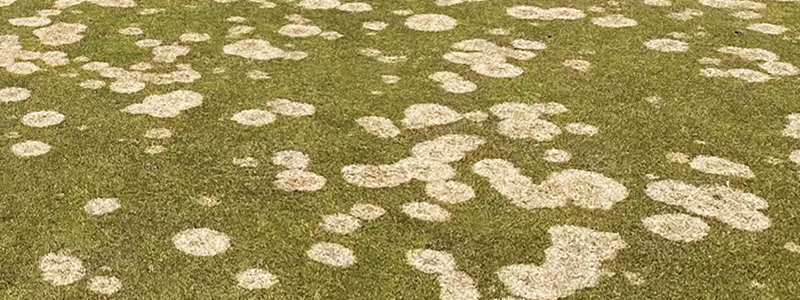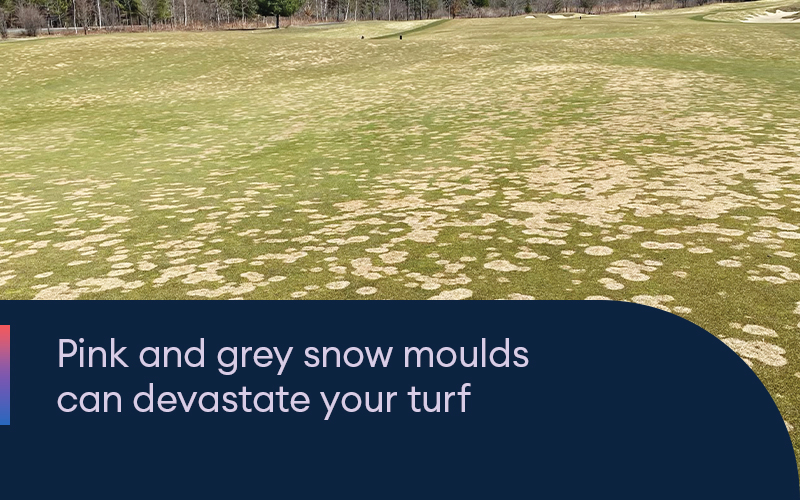Proactive Snow Mould Management
Autumn is the time of year when pathogens associated with snow mould diseases start to develop. Now is the perfect time to be proactive and consider preventative applications to reduce the potential for snow mould to affect your turf.
A quick refresher on snow mould
As you know, snow moulds pose a persistent challenge, manifesting as discoloured patches affecting leaves, stems and crowns across multiple varieties of turfgrass with annual bluegrass and creeping bentgrass being particularly vulnerable. Pink and grey snow moulds can render putting greens, tees and fairways unsightly and unplayable when spring arrives.
Snow mould thrives under snow cover and temperatures at 0-10 °C, but sclerotia of the pathogens begins to germinate in the fall when air temperature is 10-18 °C.
Microdochium patch and snow mould are caused by the same fungus, Microdochium nivale. With snow mould, the disease occurs under snow cover while Microdochium patch does not need snow cover to begin causing damage.
Like many diseases, maintaining healthy turf proves effective in warding off snow mould. Practices such as aerating to reduce compaction and minimize thatch, as well as the strategic application of nitrogen on greens or moderate nitrogen applications on higher-mowed turf in the fall, can bolster your defenses. In spring, swift snow removal from greens, tees and fairways is paramount, and any obstructions impeding water drainage, including collar dams, should be promptly cleared.
Special attention should be directed toward young turf sown in the fall. Newly grown turf, heavily fertilized, tends to be more tender, rendering it more susceptible to snow mould pressure during the autumn season.

Fungicide timing
Timing your snow mould application is important. Research from the University of Wisconsin shows the optimal timing of a fungicide application to protect against snow mould is within two weeks prior to snowfall. Applying product too early can result in a loss in control by 40% or more as the fungicide can start to degrade before snow arrives.
A significant rainfall between the final fungicide application and snow cover might mean another application is required to achieve desired disease control and ensure a successful spring.
An early fungicide application can reduce pressure
An application of Mirage® Stressgard® or Dedicate® Stressgard® in late fall months will aid in controlling any lingering late-season dollar spot and cool-season diseases, like leaf spot and Microdochium patch. This will keep the turf in a healthy condition for the snow mould season, limiting later disease development and improving long-term control.
After the initial application, follow-up with a snow mould fungicide prior to the first snowfall. A single, well-timed application is often enough to keep turf protected from snow mould, even in high pressure areas.
Dedicate Stressgard contains the leading DMI chemistry of tebuconazole premixed with the QoI fungicide trifloxystrobin. This combination is blended with Stressgard Technology to deliver consistent and reliable results for snow mould control.
In high-pressure situations on high-quality turf such as putting greens, tank-mixing Dedicate Stressgard with fludioxonil has proven to be a winning combination to knock out snow mould.
For more information, download the snow mould solution sheet or contact your local Territory Sales Manager for snow mould control strategies specific to your needs.
ALWAYS READ AND FOLLOW PESTICIDE LABEL DIRECTIONS. Envu, the Envu logo, Mirage® Stressgard® and Dedicate® Stressgard® are trademarks owned by Environmental Science U.S. LLC. or one of its affiliates. ©2023 Environmental Science U.S. LLC. All rights reserved.

